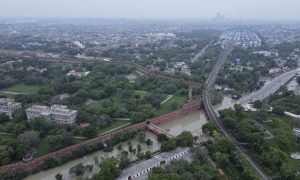In recent weeks, India’s capital New Delhi has suffered its worst floods in four decades. Visuals of the city show flood waters inundating not just the low-lying areas near the Yamuna River but also reaching the power corridors in the heart of the capital – the Supreme Court, the Delhi Secretariat and the ITO area.
The flooding, which began in early July, worsened on July 18. The waters then receded a bit. But the Yamuna River continues to hover around the danger mark and Delhi could be faced with another deluge.
The severity of the flood crisis can be gauged from the fact that the Yamuna River crossed the “danger mark” of 205.33 meters to reach its highest-ever recorded level of 208.66 meters.
The Yamuna’s waters flooded the city and reached the ramparts of the historic Red Fort, a Mughal-era monument in Old Delhi. Social media was inundated with pictures drawing parallels between the inundated Red Fort and visuals from four centuries ago when the Yamuna River flowed alongside the fort during Emperor Shah Jahan’s reign.
Environmentalists say that the crisis is not entirely unexpected. It has been precipitated by the rampant construction of concrete structures on the Yamuna floodplains and the continuing building of illegal encroachments along its banks. They have long pointed out that concrete infringement of the Yamuna’s banks obstructs the natural flow of the river, and that the building of massive concrete structures on the floodplains prevents them from functioning as a catchment area for excess water discharge during flooding.
More than a decade ago, environmentalists went to court to challenge the construction of the Commonwealth Games village on the Yamuna floodplain. The then-Delhi government rushed to the Supreme Court to ensure the construction could continue unhindered. In 2009, the Supreme Court bench allowed the construction of the Games village on the Yamuna floodplain for the 2010 Commonwealth Games. Apart from the CWG village, other prominent structures that have been built on the river’s floodplains include the sprawling Akshardham Temple complex, the Yamuna Bank Metro station and the Delhi Secretariat.
According to A.K Gosain, professor emeritus at the Indian Institute of Technology-Delhi and member of the National Green Tribunal (NGT), “illegal encroachments on the floodplains have left less space for the river to flow.” Moreover, the sandy soil in the floodplains had the capacity to absorb the floodwaters but the natural flow of the river is now obstructed, he told The Hindu.
The NGT had time and again urged the authorities to ensure that the banks of the Yamuna were free of encroachments and that embankments were built at a distance so that the flow of the river was not impeded. It also warned of “grave environmental disasters” if its orders were not complied with. Yet, its warnings went unheeded and encroachments continue, unmindful of their environmental impact. This has been the case with the Central Vista project in the heart of the capital which the Narendra Modi government pressed ahead with, despite environmental concerns being raised.
The recent flooding brought normal life in Delhi to a halt and threw traffic out of gear. Tens of thousands of Delhi’s poor, who live in the low-lying areas along the Yamuna embankment were forced to flee to higher areas to escape the flood waters. Over 27,000 people had to be evacuated. They are now living in makeshift shelters along the highway, with some even taking shelter under flyovers.
A public interest litigation was filed in the Delhi High Court to ensure basic facilities like drinking water, food and toilets were provided to those staying at temporary relief camps. The High Court has asked the Delhi government to file a status report on what steps it has taken to improve the conditions in these camps.
Delhi’s flooding set off a blame game between the Bharatiya Janata Party (BJP)-led central government (headquartered in the capital) and the Aam Aadmi Party (AAP), which governs Delhi.
Under fire from all quarters, the Delhi government, which is responsible for managing the ground situation, blamed the neighboring state of Haryana, which is ruled by the BJP, for the flooding. AAP spokesperson Sanjay Singh alleged that the release of water from the Haryana government-controlled Hathnikund barrage “only towards Delhi” and not to neighboring Uttar Pradesh had caused “the flood-like situation” in the capital. BJP legislators hit back, blaming the Delhi government for not desilting the Yamuna effectively.
Water conservationist Rajendra Singh drew attention to the multiple agencies that are involved in managing the Yamuna. Political differences among them had led to the unprecedented floods in the capital, he said.
Even when it is not flooding, the Yamuna poses a threat to public health. A visitor to Delhi could easily mistake the river for a filthy, open sewer. Flowing 54 kilometers through Delhi, the river has been reduced to a stinking black drain, choked with sewage and industrial effluents. Half-hearted attempts at cleaning the river over the decades have had little impact.
With record-breaking rains and floods ravaging the hillsides all over North India, exacerbated by climate change, the impact is being felt downstream in the Yamuna. The situation in the coming years will only get worse. Those that suffer most will always be the citizens of Delhi while politicians continue to play politics over the issue.

































